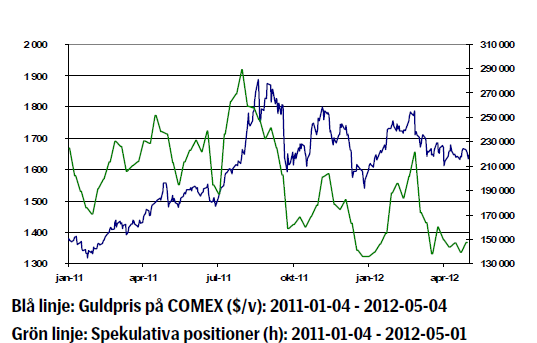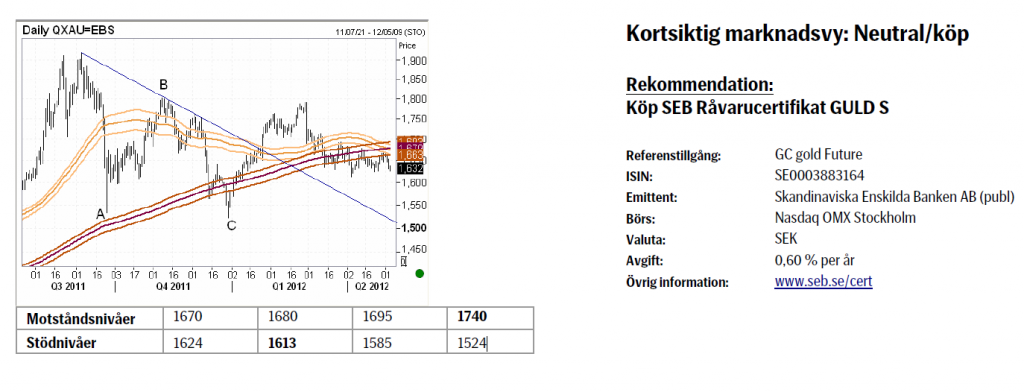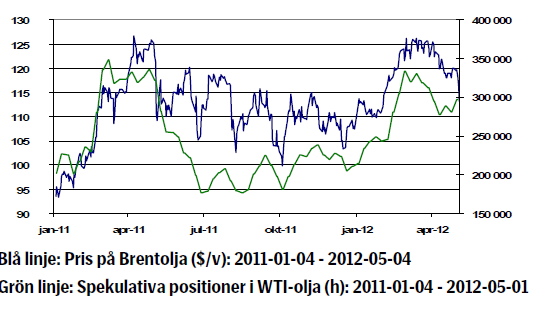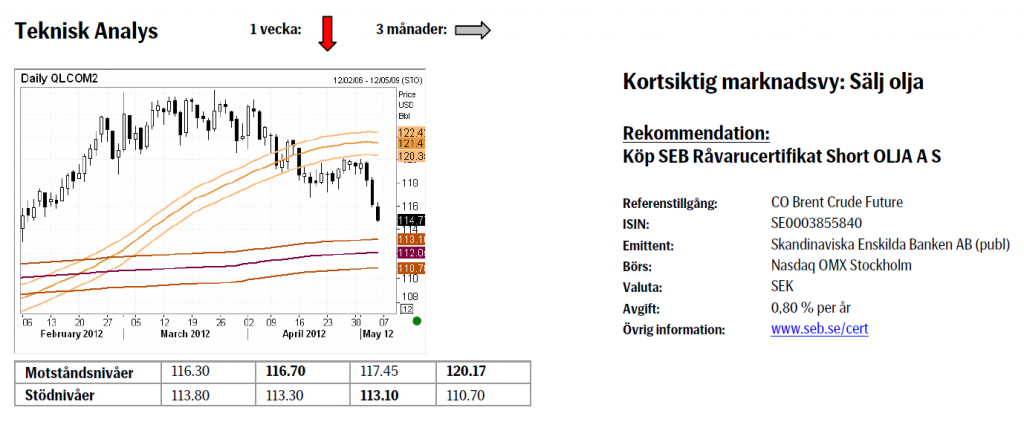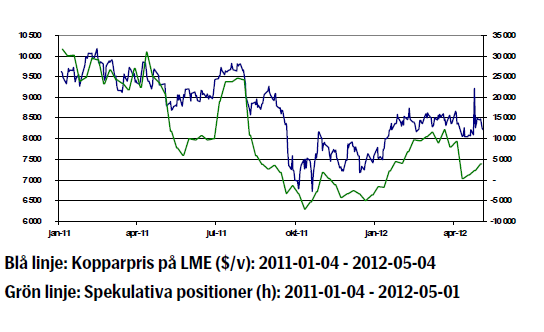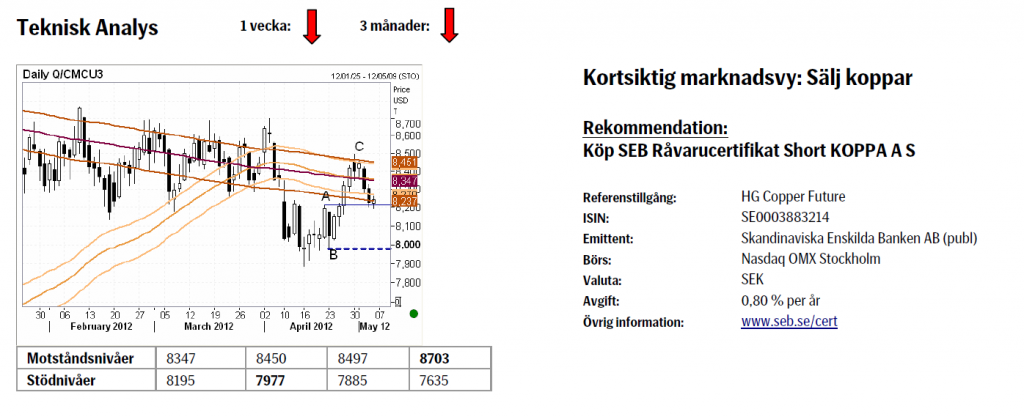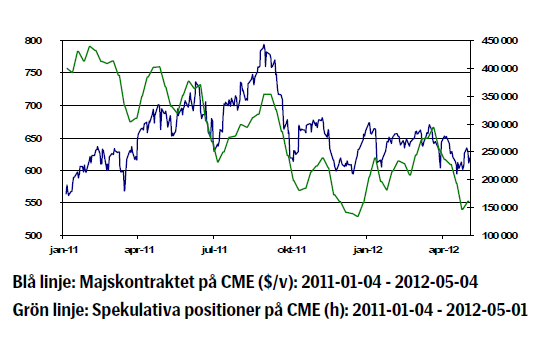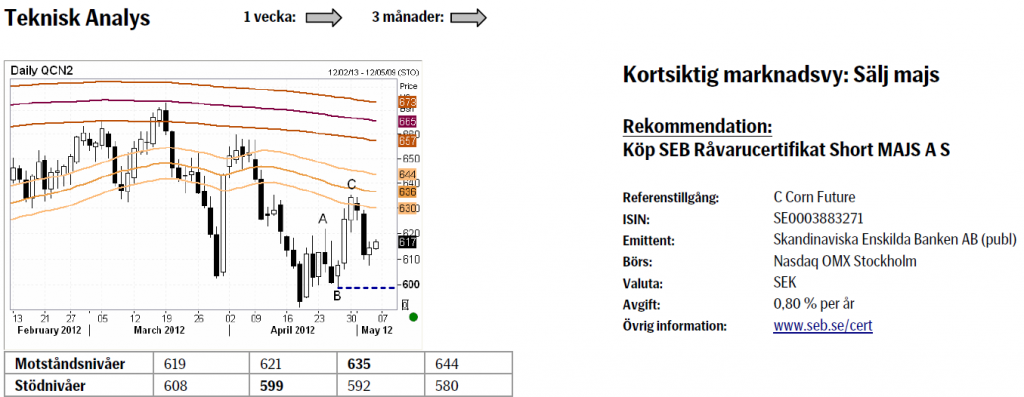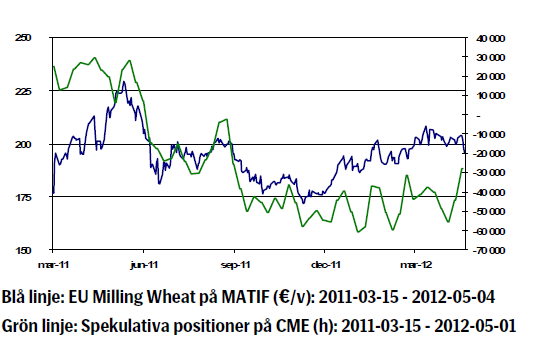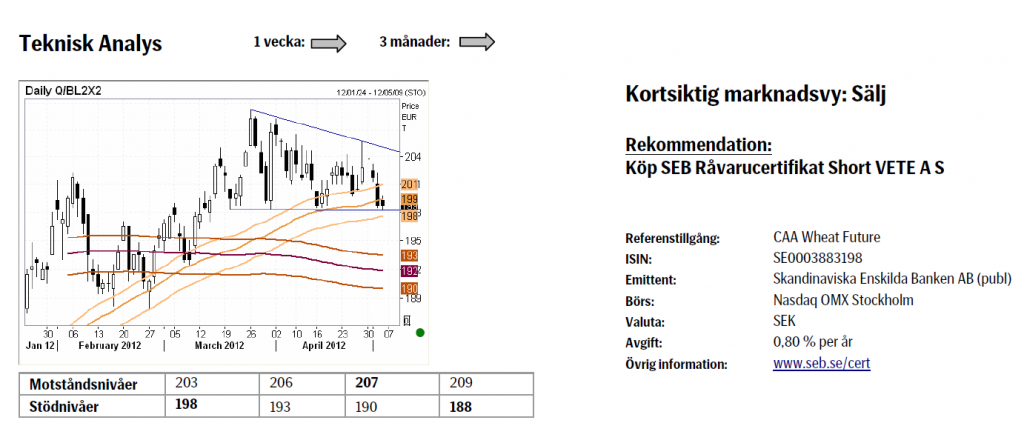Analys
SEB – Råvarukommentarer vecka 19 2012
Sammanfattning: Föregående vecka
 Brett råvaruindex: -2,79 %
Brett råvaruindex: -2,79 %
UBS Bloomberg CMCI TR Index- Energi: -4,31 %
UBS Bloomberg CMCI Energy TR Index - Ädelmetaller: -1,59%
UBS Bloomberg CMCI Precious Metals TR Index - Industrimetaller: -2,42 %
UBS Bloomberg CMCI Industrial Metals TR Index - Jordbruk: -2,01 %
UBS Bloomberg CMCI Agriculture TR Index
Kortsiktig marknadsvy:
- Guld: Neutral/köp
- Olja: Sälj
- Koppar: Sälj
- Majs: Sälj
- Vete: Sälj
Guld
- Guldet föll 1,14 procent förra veckan och vi såg att guldtillgångar i börshandlade ETP: er sjönk till 2 381 ton, den lägsta nivån sedan 1 februari i år. Guldet handlade i ett intervall och lyckas inte bryta på uppsidan. Bristen på av politiker bekräftade penningpolitiska lättnader och en starkare dollar höll tillbaka guldet.
- Den amerikanska jobbrapporten NFP som publiceras i fredags kom ut sämre än förväntat, 115 000 nya jobb mot förväntade 160 000 nya jobb skapades. NFP siffran ökade marknadens förhoppningar om nya kvantitativa lättnader vilket gav stöd åt guldet som steg en halv procent samtidigt dollarn försvagades marginellt.
- Råvaror faller brett idag på morgonen efter valseger för Hollande i Frankrike. Segern skapar politisk oro eftersom överenskommelser med Tyskland nu kan komma att rivas upp. Helgens val i Grekland gav en klar seger för små partier som visat missnöje med de överenskommelser landets största partier gjort med EU och IMF. Osäkerheten i Europa ökar och euron tappade kraftigt mot dollarn efter valresultaten.
- I Europa är osäkerheten kring Spanien stor där ekonomin åter är i recession, dvs. ekonomin krymper för andra kvartalet i rad. En fråga som oroar marknaden är om Spanien kommet att behöva resurser från EU:s nödlånefaciliteter. Negativa nyheter kan snabbt skapa turbulens i marknaden. Den oro man ser i Europa har emellertid inte ökat intresset för guld som säker hamn. Guldet har snarare korrelerat positivt med övriga risktillgångar.
- Teknisk Analys: Fortsatt endast marginella rörelser noterade inom ett redan ganska väl utstakat intervall där under $1620 verkar ”för lågt” och over $1690 ”för högt”. Priset håller sig under ett rullande 55-dagars genomsinittsband. Bandet är svagt i fallande och är på marginalen ett uttryck för visst nedåttryck, men marknaden svarar samtidigt bra på nedställ och i en större positiv bild ser eventuell svaghet ut at vara temporär. Över $1670 & $1695 skulle påvisa efterfrågan och ses som positivt.
Olja
- Oljepriset föll 5,3 procent förra veckan. Statistik från USA:s energidepartement, DOE, visade att de amerikanska lagren av råolja steg med 2,8 miljoner fat under förra veckan till den högsta nivån på 21 år.
- Den viktiga amerikanska jobbrapporten NFP som publiceras på fredagen kom ut sämre än förväntat, 115 000 nya jobb mot förväntade 160 000 nya jobb skapades.
- Arbetslösheten minskade med 0,1 % och föll till 8,1 procent (samtidigt bör noteras att antalet registrerade arbetslösa minskade, de försvinner alltså ur systemet vilket i sig förbättrar siffran).
- Den inofficiell amerikanska jobbstatistiken, ADP-rapporten, som mäter utvecklingen i den privata sysselsättningen, visade på en ökning om 119 000 personer vilket också var långt under väntade 170 000.)
- Opec:s generalsekreterare är “inte nöjd” över nuvarande oljepris och kartellen arbetar för att få ned priserna. Enligt Opec som idag producerar 3,2 miljoner fat per dag över de uppsatta kvoterna, är ett oljepris kring 100 dollar att föredra. Enligt Opec finns det gott om olja och utbudssituationen är inte ett problem trots Irankrisen. Exporten från Iran har minskat mindre än förväntat. Detta, tillsammans med Europas kris, gör att vi kortsiktigt inte tror på en uppgång i oljepriset.
- Teknisk Analys: Undersidan av 55-dagars bandet (som efter kraftigt nedställ denna vecka är satt i fallande) agerar som dynamisk motstånd (borde inte återtestas under de kommande veckorna). Rörelsen ner är som sagt hård och ska väntas fortsätta för att testa 233-dagars bandet som just nu börjar vid $113.
Koppar
- Kopparlagren på LME (London Metal Exchange) föll förra veckan till den lägsta nivån sedan november 2008.
- HSBC inköpschefsindex för tillverkningsindustrin kom in under 50-nivån vilket är den nivå som indikerar att ekonomin är i kontraktion. Fastighetspriser i Kina faller och föll i april till 14-månaders lägsta. Husbyggande står för ungefär 40 procent av inhemsk efterfrågan på koppar enligt Copper Development Association.
- ECB lämnade som förväntat räntan oförändrad på en procent. Störst fokus var emellertid på ECB chefen Draghis efterföljande presskonferens i samband med räntebeskedet där Draghi uttryckte kritik mot euro-ländernas politiker vilka inte har förbättrat tillväxtpotentialen med förbättrade strukturreformer. Framtiden ser osäker ut enligt Draghi som inte heller utlovade ytterligare stimulanser vilket marknaden reagerade negativt på och råvaror fortsatte att falla brett på fredagen i samklang med aktiemarknaden.
- Stämningsläget hos europeiska inköpschefer bekräftade det kärva läge som europeisk tillväxt befinner sig i. Arbetsmarknadsstatistiken är dyster och den europeiska arbetslösheten har stigit till 15-årshögsta. Obligationsräntorna har rört sig nedåt eller ligger kvar på mycket låga nivåer t.o.m. i ekonomier som bedöms som säkra att låna ut till.
- Teknisk Analys: Rörelsen högre gick något längre än vad som tidigare var trott, men uppsidan av 55-, & 233-dagars ”banden” höll köpare över $8500 nivån borta. Den nuvarande överlappningen under 20 april toppen vid $8218 har ökat sannolikheten att apr/maj rörelsen verkligen är den korrektion vi antagit att den är. Under $$7977 skulle helt bekräfta detta och starkt argumentera för fortsatt rörelse under apr botten vid 7885.
Majs
- Denna vecka byter vi referenskontrakt för majs. Från att den senaste tiden ha använt majkontraktet byter vi nu istället till julikontraktet.
- Förra veckan kunde vi se en nedgång med knappt en procent, detta till följd av framförallt den fortsatt goda utvecklingen för den amerikanska majsskörden, där mer än 50 procent av planteringen nu är avslutad.
- Prognoserna för den sydamerikanska majsskörden ser fortsatt blandade ut, där Brasilien som kontinentens största producent justerat upp sin prognos samtidigt som Argentina fått dra ned sina estimat något.
- Den senaste tiden har det spekulerats mycket kring Kinas ökade import av majs och huruvida denna kommer att fortlöpa under 2012. Enligt en mängd analytiker verkar det i nuläget som att importen kommer att öka något, vilket borde utgöra ett starkt fundamentalt motstånd för majspriset.
- Fundamentalt förhåller vi oss fortsatt negativa till majspriset, där fredagens amerikanska arbetsmarknadsdata, tillsammans med den generella riskaversionen i kapitalmarknaden, bör agera sänke även på spannmålspriserna denna vecka.
- Teknisk Analys: Rörelsen upp från apr botten har kommit av sig och börjat se ut som en korrektiv ”3-vågs” rörelse där A-, & C-vågorna nu är symmetriska i storlek och hastighet. Tillbaka under 599 skulle till fullo bekräfta detta och den lätt negativa lutningen på 55-dagars bandet och då argumentera för rörelse under 592, möjligtvis ner mot 580-området.
Vete
- Efter att den senaste månaden ha använt majkontraktet som referenskontrakt för europeiskt vete byter vi nu över till novemberkontraktet.
- Förra veckan föll priset på vete med nästan 3,5 procent, vilket till stor del kan förklaras av den amerikanska skördeutvecklingen, där 64 procent av vintervetet är av hög eller mycket hög kvalitet. Den gängse normen på marknaden är att en siffra över 60 procent i regel leder till hög avkastning på skörden.
- I Europa är det fortsatt blandat, där exempelvis skörden i Ukraina och Spanien i år ser ut att bli väsentligen sämre jämfört med föregående skördeår. I länder som Ryssland och Frankrike ser det däremot förhållandevis ljust ut, där det blöta vädret under april och maj skapat förutsättningar för en god avkastning.
- Som en konsekvens av rådande riskaversion samt de goda utsikterna för den amerikanska skörden är vi denna vecka säljare av vete. Det krävs en svag WASDE-rapport på torsdag för att vi ska revidera denna kortsiktiga vy.
- Teknisk Analys: Fallande toppar indikerar ett något höjt säljtryck. Skulle stödet just under €200-nivån (& nedsidan på 55-dagars bandet) sluta att attrahera köpare så väntas snabb rörelse tillbaka ner mot stödet vid 233-dagars bandet (som är i fallande) och som börjar vid €193. Över €206 skulle åter minska risken för brott lägre och i stället tas som efterfrågan vid nivåer som tidigare.
[box]SEB Veckobrev Veckans råvarukommentar är producerat av SEB Merchant Banking och publiceras i samarbete och med tillstånd på Råvarumarknaden.se[/box]
Disclaimer
The information in this document has been compiled by SEB Merchant Banking, a division within Skandinaviska Enskilda Banken AB (publ) (“SEB”).
Opinions contained in this report represent the bank’s present opinion only and are subject to change without notice. All information contained in this report has been compiled in good faith from sources believed to be reliable. However, no representation or warranty, expressed or implied, is made with respect to the completeness or accuracy of its contents and the information is not to be relied upon as authoritative. Anyone considering taking actions based upon the content of this document is urged to base his or her investment decisions upon such investigations as he or she deems necessary. This document is being provided as information only, and no specific actions are being solicited as a result of it; to the extent permitted by law, no liability whatsoever is accepted for any direct or consequential loss arising from use of this document or its contents.
About SEB
SEB is a public company incorporated in Stockholm, Sweden, with limited liability. It is a participant at major Nordic and other European Regulated Markets and Multilateral Trading Facilities (as well as some non-European equivalent markets) for trading in financial instruments, such as markets operated by NASDAQ OMX, NYSE Euronext, London Stock Exchange, Deutsche Börse, Swiss Exchanges, Turquoise and Chi-X. SEB is authorized and regulated by Finansinspektionen in Sweden; it is authorized and subject to limited regulation by the Financial Services Authority for the conduct of designated investment business in the UK, and is subject to the provisions of relevant regulators in all other jurisdictions where SEB conducts operations. SEB Merchant Banking. All rights reserved.
Analys
More weakness and lower price levels ahead, but the world won’t drown in oil in 2026

Some rebound but not much. Brent crude rebounded 1.5% yesterday to $65.47/b. This morning it is inching 0.2% up to $65.6/b. The lowest close last week was on Thursday at $64.11/b.

The curve structure is almost as week as it was before the weekend. The rebound we now have gotten post the message from OPEC+ over the weekend is to a large degree a rebound along the curve rather than much strengthening at the front-end of the curve. That part of the curve structure is almost as weak as it was last Thursday.
We are still on a weakening path. The message from OPEC+ over the weekend was we are still on a weakening path with rising supply from the group. It is just not as rapidly weakening as was feared ahead of the weekend when a quota hike of 500 kb/d/mth for November was discussed.
The Brent curve is on its way to full contango with Brent dipping into the $50ies/b. Thus the ongoing weakening we have had in the crude curve since the start of the year, and especially since early June, will continue until the Brent crude oil forward curve is in full contango along with visibly rising US and OECD oil inventories. The front-month Brent contract will then flip down towards the $60/b-line and below into the $50ies/b.
At what point will OPEC+ turn to cuts? The big question then becomes: When will OPEC+ turn around to make some cuts? At what (price) point will they choose to stabilize the market? Because for sure they will. Higher oil inventories, some more shedding of drilling rigs in US shale and Brent into the 50ies somewhere is probably where the group will step in.
There is nothing we have seen from the group so far which indicates that they will close their eyes, let the world drown in oil and the oil price crash to $40/b or below.
The message from OPEC+ is also about balance and stability. The world won’t drown in oil in 2026. The message from the group as far as we manage to interpret it is twofold: 1) Taking back market share which requires a lower price for non-OPEC+ to back off a bit, and 2) Oil market stability and balance. It is not just about 1. Thus fretting about how we are all going to drown in oil in 2026 is totally off the mark by just focusing on point 1.
When to buy cal 2026? Before Christmas when Brent hits $55/b and before OPEC+ holds its last meeting of the year which is likely to be in early December.
Brent crude oil prices have rebounded a bit along the forward curve. Not much strengthening in the structure of the curve. The front-end backwardation is not much stronger today than on its weakest level so far this year which was on Thursday last week.

The front-end backwardation fell to its weakest level so far this year on Thursday last week. A slight pickup yesterday and today, but still very close to the weakest year to date. More oil from OPEC+ in the coming months and softer demand and rising inventories. We are heading for yet softer levels.

Analys
A sharp weakening at the core of the oil market: The Dubai curve

Down to the lowest since early May. Brent crude has fallen sharply the latest four days. It closed at USD 64.11/b yesterday which is the lowest since early May. It is staging a 1.3% rebound this morning along with gains in both equities and industrial metals with an added touch of support from a softer USD on top.

What stands out the most to us this week is the collapse in the Dubai one to three months time-spread.
Dubai is medium sour crude. OPEC+ is in general medium sour crude production. Asian refineries are predominantly designed to process medium sour crude. So Dubai is the real measure of the balance between OPEC+ holding back or not versus Asian oil demand for consumption and stock building.
A sharp weakening of the front-end of the Dubai curve. The front-end of the Dubai crude curve has been holding out very solidly throughout this summer while the front-end of the Brent and WTI curves have been steadily softening. But the strength in the Dubai curve in our view was carrying the crude oil market in general. A source of strength in the crude oil market. The core of the strength.
The now finally sharp decline of the front-end of the Dubai crude curve is thus a strong shift. Weakness in the Dubai crude marker is weakness in the core of the oil market. The core which has helped to hold the oil market elevated.
Facts supports the weakening. Add in facts of Iraq lifting production from Kurdistan through Turkey. Saudi Arabia lifting production to 10 mb/d in September (normal production level) and lifting exports as well as domestic demand for oil for power for air con is fading along with summer heat. Add also in counter seasonal rise in US crude and product stocks last week. US oil stocks usually decline by 1.3 mb/week this time of year. Last week they instead rose 6.4 mb/week (+7.2 mb if including SPR). Total US commercial oil stocks are now only 2.1 mb below the 2015-19 seasonal average. US oil stocks normally decline from now to Christmas. If they instead continue to rise, then it will be strongly counter seasonal rise and will create a very strong bearish pressure on oil prices.
Will OPEC+ lift its voluntary quotas by zero, 137 kb/d, 500 kb/d or 1.5 mb/d? On Sunday of course OPEC+ will decide on how much to unwind of the remaining 1.5 mb/d of voluntary quotas for November. Will it be 137 kb/d yet again as for October? Will it be 500 kb/d as was talked about earlier this week? Or will it be a full unwind in one go of 1.5 mb/d? We think most likely now it will be at least 500 kb/d and possibly a full unwind. We discussed this in a not earlier this week: ”500 kb/d of voluntary quotas in October. But a full unwind of 1.5 mb/d”
The strength in the front-end of the Dubai curve held out through summer while Brent and WTI curve structures weakened steadily. That core strength helped to keep flat crude oil prices elevated close to the 70-line. Now also the Dubai curve has given in.

Brent crude oil forward curves

Total US commercial stocks now close to normal. Counter seasonal rise last week. Rest of year?

Total US crude and product stocks on a steady trend higher.

Analys
OPEC+ will likely unwind 500 kb/d of voluntary quotas in October. But a full unwind of 1.5 mb/d in one go could be in the cards

Down to mid-60ies as Iraq lifts production while Saudi may be tired of voluntary cut frugality. The Brent December contract dropped 1.6% yesterday to USD 66.03/b. This morning it is down another 0.3% to USD 65.8/b. The drop in the price came on the back of the combined news that Iraq has resumed 190 kb/d of production in Kurdistan with exports through Turkey while OPEC+ delegates send signals that the group will unwind the remaining 1.65 mb/d (less the 137 kb/d in October) of voluntary cuts at a pace of 500 kb/d per month pace.

Signals of accelerated unwind and Iraqi increase may be connected. Russia, Kazakhstan and Iraq were main offenders versus the voluntary quotas they had agreed to follow. Russia had a production ’debt’ (cumulative overproduction versus quota) of close to 90 mb in March this year while Kazakhstan had a ’debt’ of about 60 mb and the same for Iraq. This apparently made Saudi Arabia angry this spring. Why should Saudi Arabia hold back if the other voluntary cutters were just freeriding? Thus the sudden rapid unwinding of voluntary cuts. That is at least one angle of explanations for the accelerated unwinding.
If the offenders with production debts then refrained from lifting production as the voluntary cuts were rapidly unwinded, then they could ’pay back’ their ’debts’ as they would under-produce versus the new and steadily higher quotas.
Forget about Kazakhstan. Its production was just too far above the quotas with no hope that the country would hold back production due to cross-ownership of oil assets by international oil companies. But Russia and Iraq should be able to do it.
Iraqi cumulative overproduction versus quotas could reach 85-90 mb in October. Iraq has however steadily continued to overproduce by 3-5 mb per month. In July its new and gradually higher quota came close to equal with a cumulative overproduction of only 0.6 mb that month. In August again however its production had an overshoot of 100 kb/d or 3.1 mb for the month. Its cumulative production debt had then risen to close to 80 mb. We don’t know for September yet. But looking at October we now know that its production will likely average close to 4.5 mb/d due to the revival of 190 kb/d of production in Kurdistan. Its quota however will only be 4.24 mb/d. Its overproduction in October will thus likely be around 250 kb/d above its quota with its production debt rising another 7-8 mb to a total of close to 90 mb.
Again, why should Saudi Arabia be frugal while Iraq is freeriding. Better to get rid of the voluntary quotas as quickly as possible and then start all over with clean sheets.
Unwinding the remaining 1.513 mb/d in one go in October? If OPEC+ unwinds the remaining 1.513 mb/d of voluntary cuts in one big go in October, then Iraq’s quota will be around 4.4 mb/d for October versus its likely production of close to 4.5 mb/d for the coming month..
OPEC+ should thus unwind the remaining 1.513 mb/d (1.65 – 0.137 mb/d) in one go for October in order for the quota of Iraq to be able to keep track with Iraq’s actual production increase.
October 5 will show how it plays out. But a quota unwind of at least 500 kb/d for Oct seems likely. An overall increase of at least 500 kb/d in the voluntary quota for October looks likely. But it could be the whole 1.513 mb/d in one go. If the increase in the quota is ’only’ 500 kb/d then Iraqi cumulative production will still rise by 5.7 mb to a total of 85 mb in October.
Iraqi production debt versus quotas will likely rise by 5.7 mb in October if OPEC+ only lifts the overall quota by 500 kb/d in October. Here assuming historical production debt did not rise in September. That Iraq lifts its production by 190 kb/d in October to 4.47 mb/d (August level + 190 kb/d) and that OPEC+ unwinds 500 kb/d of the remining quotas in October when they decide on this on 5 October.

-

 Nyheter4 veckor sedan
Nyheter4 veckor sedanMahvie Minerals i en guldtrend
-

 Analys4 veckor sedan
Analys4 veckor sedanVolatile but going nowhere. Brent crude circles USD 66 as market weighs surplus vs risk
-

 Nyheter4 veckor sedan
Nyheter4 veckor sedanAktier i guldbolag laggar priset på guld
-

 Nyheter3 veckor sedan
Nyheter3 veckor sedanKinas elproduktion slog nytt rekord i augusti, vilket även kolkraft gjorde
-

 Nyheter3 veckor sedan
Nyheter3 veckor sedanTyskland har så höga elpriser att företag inte har råd att använda elektricitet
-

 Nyheter4 veckor sedan
Nyheter4 veckor sedanGuld når sin högsta nivå någonsin, nu även justerat för inflation
-

 Nyheter4 veckor sedan
Nyheter4 veckor sedanDet stigande guldpriset en utmaning för smyckesköpare
-

 Analys4 veckor sedan
Analys4 veckor sedanWaiting for the surplus while we worry about Israel and Qatar


